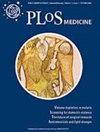Impact on beer sales of removing the pint serving size: An A-B-A reversal trial in pubs, bars, and restaurants in England
IF 9.9
1区 医学
Q1 MEDICINE, GENERAL & INTERNAL
引用次数: 0
Abstract
Background Smaller serving sizes could contribute towards reducing alcohol consumption across populations and thereby decrease the risk of 7 cancers and other diseases. To our knowledge, the current study is the first to assess the impact on beer, lager, and cider sales (hereafter, for ease, referred to just as “beer sales”) of removing the largest draught serving size (1 imperial pint) from the options available in licensed premises under real-word conditions. Methods and findings The study was conducted between February and May 2023, in 13 licensed premises in England. It used an A-B-A reversal design, set over 3 consecutive 4-weekly periods with “A” representing the nonintervention periods during which standard serving sizes were served, and “B” representing the intervention period when the largest serving size of draught beer (1 imperial pint (568 ml)) was removed from existing ranges so that the largest size available was two-thirds of a pint. Where two-third pints were not served, the intervention included introducing this serving size in conjunction with removing the pint serving size. The primary outcome was the mean daily volume of all beer sold, including draught, bottles, and cans (in ml), extracted from electronic sales data. Secondary outcomes were mean daily volume of wine sold (ml) and daily revenue (£). Thirteen premises completed the study, 12 of which did so per protocol and were included in the primary analysis. After adjusting for prespecified covariates, the intervention resulted in a mean daily change of −2,769 ml (95% CI [−4,188, −1,578]取消一品脱啤酒分量对啤酒销量的影响:在英格兰酒馆、酒吧和餐馆进行的 A-B-A 反向试验
背景较小的食用分量有助于减少人口中的酒精消费量,从而降低罹患 7 种癌症和其他疾病的风险。据我们所知,目前的研究是首次评估在真实条件下,从持证经营场所的选择中取消最大的吃水份量(1 英制品脱)对啤酒、拉格啤酒和苹果酒销量(以下简称 "啤酒销量")的影响。研究方法和结果 这项研究于 2023 年 2 月至 5 月间在英格兰 13 个持证经营场所进行。研究采用了 A-B-A 反转设计,连续 3 次,每次 4 周,其中 "A "代表非干预期,在此期间提供标准份量的啤酒;"B "代表干预期,在此期间,最大份量的扎啤(1 英制品脱(568 毫升))从现有范围中去除,因此最大份量为三分之二品脱。在不供应三分之二品脱啤酒的地方,干预措施包括在取消一品脱啤酒供应量的同时引入这种供应量。主要结果是从电子销售数据中提取的所有啤酒的日平均销售量,包括扎啤、瓶装啤酒和罐装啤酒(单位:毫升)。次要结果是葡萄酒的日平均销售量(毫升)和日收入(英镑)。有 13 个场所完成了研究,其中 12 个场所按照协议完成了研究,并纳入了主要分析。在对预设的协变量进行调整后,干预措施导致平均日销售量变化为-2,769 毫升(95% CI [-4,188, -1,578] p < 0.001)或啤酒销售量变化为-9.7%(95% CI [-13.5%, -6.1%])。在干预期间,葡萄酒的日销售量增加了 232 毫升(95% CI [13, 487],p = 0.035)或 7.2%(95% CI [0.4%, 14.5%])。每日收入减少 5.0% (95% CI [9.6%, -0.3%], p = 0.038)。结论 取消生啤的最大份量(英制品脱)减少了啤酒的销售量。鉴于这种干预措施具有减少酒精消费的潜力,值得在酒精控制政策中加以考虑。试验注册 ISRCTN.com ISRCTN18365249。
本文章由计算机程序翻译,如有差异,请以英文原文为准。
求助全文
约1分钟内获得全文
求助全文
来源期刊

PLoS Medicine
医学-医学:内科
CiteScore
21.60
自引率
0.60%
发文量
227
审稿时长
3 months
期刊介绍:
PLOS Medicine aims to be a leading platform for research and analysis on the global health challenges faced by humanity. The journal covers a wide range of topics, including biomedicine, the environment, society, and politics, that affect the well-being of individuals worldwide. It particularly highlights studies that contribute to clinical practice, health policy, or our understanding of disease mechanisms, with the ultimate goal of improving health outcomes in diverse settings.
Unwavering in its commitment to ethical standards, PLOS Medicine ensures integrity in medical publishing. This includes actively managing and transparently disclosing any conflicts of interest during the reporting, peer review, and publication processes. The journal promotes transparency by providing visibility into the review and publication procedures. It also encourages data sharing and the reuse of published work. Author rights are upheld, allowing them to retain copyright. Furthermore, PLOS Medicine strongly supports Open Access publishing, making research articles freely available to all without restrictions, facilitating widespread dissemination of knowledge. The journal does not endorse drug or medical device advertising and refrains from exclusive sales of reprints to avoid conflicts of interest.
 求助内容:
求助内容: 应助结果提醒方式:
应助结果提醒方式:


